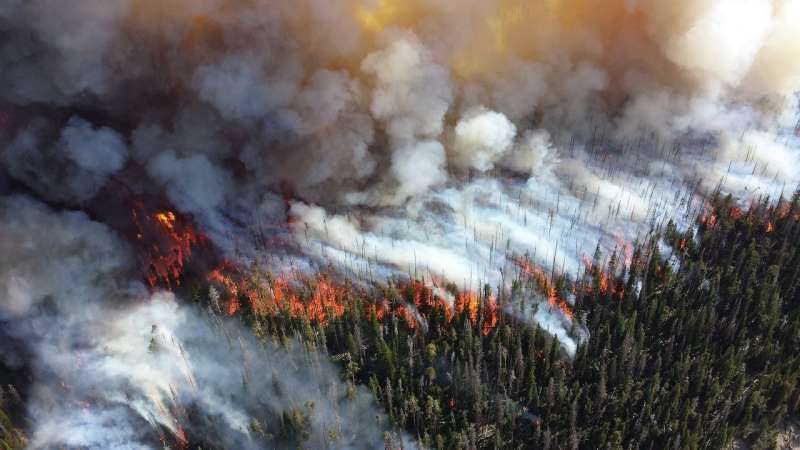Credit: CC0 Public Domain
Just as Californians have long been told to prepare for earthquakes, they must now start protecting their health from the wildfires becoming more commonplace in this state, experts warned Sunday.
That means learning how to monitor the smoke-filled air from raging fires—and avoid breathing it.
As a result of the Camp Fire burning near Paradise in Northern California, the entire Bay Area, much of the Central Valley and even Monterey—which is more than 200 miles away from the blaze, as the crow flies—are experiencing unhealthy air quality that began wafting in on seasonal winds just hours after the wildfire sparked Thursday.
"Everybody is at risk with poor air quality in the unhealthy range," Sharon Chinthrajah, a pulmonologist and allergist with Stanford Health Care, said Sunday.
Forecasters say a clearing of the smoky conditions might not occur until Tuesday or Wednesday.
Protecting yourself by staying indoors with windows and doors closed is the best bet, Chinthrajah says, as microscopic particles in the outside air can seep deep into your lungs and enter your bloodstream.
"In California, where we're being unfortunately constantly exposed to wildfires, this is becoming something that we have to be more aware of, and get the message out there to try to limit the exposure," she said.
"It's actually quite a tragedy."
She noted the most vulnerable people during these conditions are children, whose lungs are still developing, and people with underlying respiratory conditions, such as asthma and COPD. But they aren't the only ones who should take precautions.
The Air Quality Index is the federal government's system for showing air pollution levels as numbers, between 0 and 500, and is something Californians should get very familiar with.
"Anything between 150 to 200 has the potential to affect even healthy people, but patients with chronic heart or lung or conditions can also be at risk for exacerbating their underlying conditions," Chinthrajah said.
With some fluctuations, much of the Bay Area has been hovering at levels between 150 and 200 since Friday, and while some improvement was expected Monday, the Bay Area Air Quality Management District forecast shows levels could still be between 100 and 150 through Thursday.
Chinthrajah said everyone in areas affected by smoke from California's fierce fires should be checking sites like the government's AirNow, a tool that allows users to see real-time air quality data where they live. Another resource is PurpleAir, a site that displays data from a growing network of air quality detectors.
"It's really been unprecedented the last couple of years the smoke we've had in the region from wildfires," Kristine Roselius, a spokeswoman for the air district, said Sunday.
The amount of fine particulate matter registered across the Bay Area on Nov. 9 was the second-highest ever recorded since the metric started being tracked almost 20 years ago, Roselius said.
The high reading was second only to one recorded on Oct. 13, 2017, when smoky conditions were abundant in the region as a result of the much closer North Bay fires.
"This is very widespread unhealthy air quality that we're seeing, and that's kind of unusual," she said of the massive reach of the smoke from the Camp Fire, which is being directed by winds from the northeast of the state.
Events and activities including Veterans Day parades and half marathons were canceled around the region Sunday due to continuing unhealthy air conditions, and people seeking to protect themselves cleaned out hardware stores of their specialized respirator face masks, which can help filter out soot from the air.
Employees at stores in Oakland, San Jose, Fremont and Sacramento—in the capital city, the air quality index was in the very unhealthy range above 200—said they sold out of the masks known as N95 respirators either Friday or Saturday.
A regional Ace Hardware stocking warehouse in Rocklin was also said to be completely out.
But masks were in abundance at the Oakland Raiders game on Sunday afternoon, where they were handed out at the gates to any fan who wanted one.
While the masks can be effective at filtering out very small particles in the air, they must be fitted to the face properly to create an effective seal. The FDA warns on its website that N95 masks "are not designed for children or people with facial hair," and won't seal properly on them.
"People might get a false sense of security with the masks, and think they can do their normal activities outside," Roselius said, which she advised against.
Chinthrajah said if you do go out, keep your car windows closed, put the air vent systems on recirculate, and change your clothes when you return indoors, if possible. She also said those with chronic conditions should keep inhalers or other emergency remedies on hand, and set up a natural disaster readiness plan with their doctor's help.
The offshore winds that have been blowing from the northeast, whipping the flames of the deadly Camp Fire and pushing smoke into the Bay Area, are expected to taper off locally Sunday night, and in the region as a whole by Monday, according to the National Weather Service.
However, the Bay Area may not completely shake the smoky conditions until about Tuesday or Wednesday, due to a massive high-pressure system off the western coast, weather service meteorologist Matt Mehley said.
"High pressure can act like a lid," Mehley said. "So we have all the smoke being generated from the Camp Fire being pushed over the Bay Area, and then we have kind of a lid in place keeping it locked over the region."
Though the high-pressure system will likely break down Wednesday, Mehley said major weather shifts that could bring rains to the state might not occur until the week of Thanksgiving.
©2018 The Mercury News (San Jose, Calif.)
Distributed by Tribune Content Agency, LLC.
























